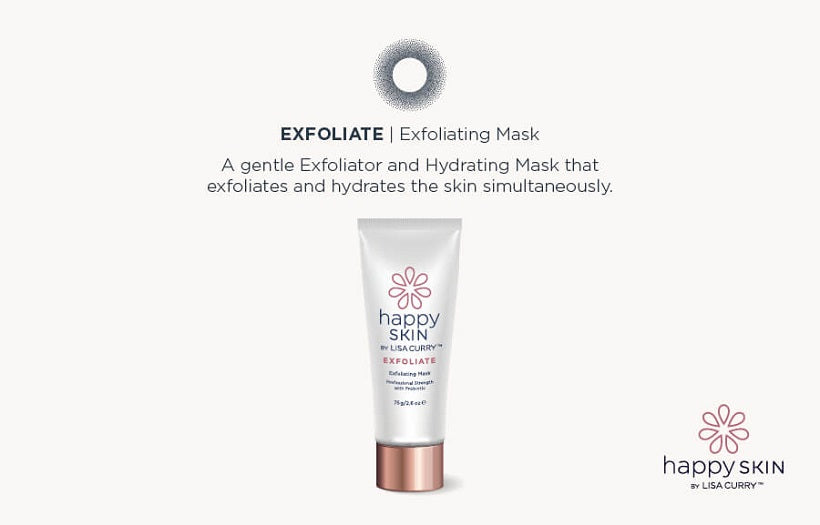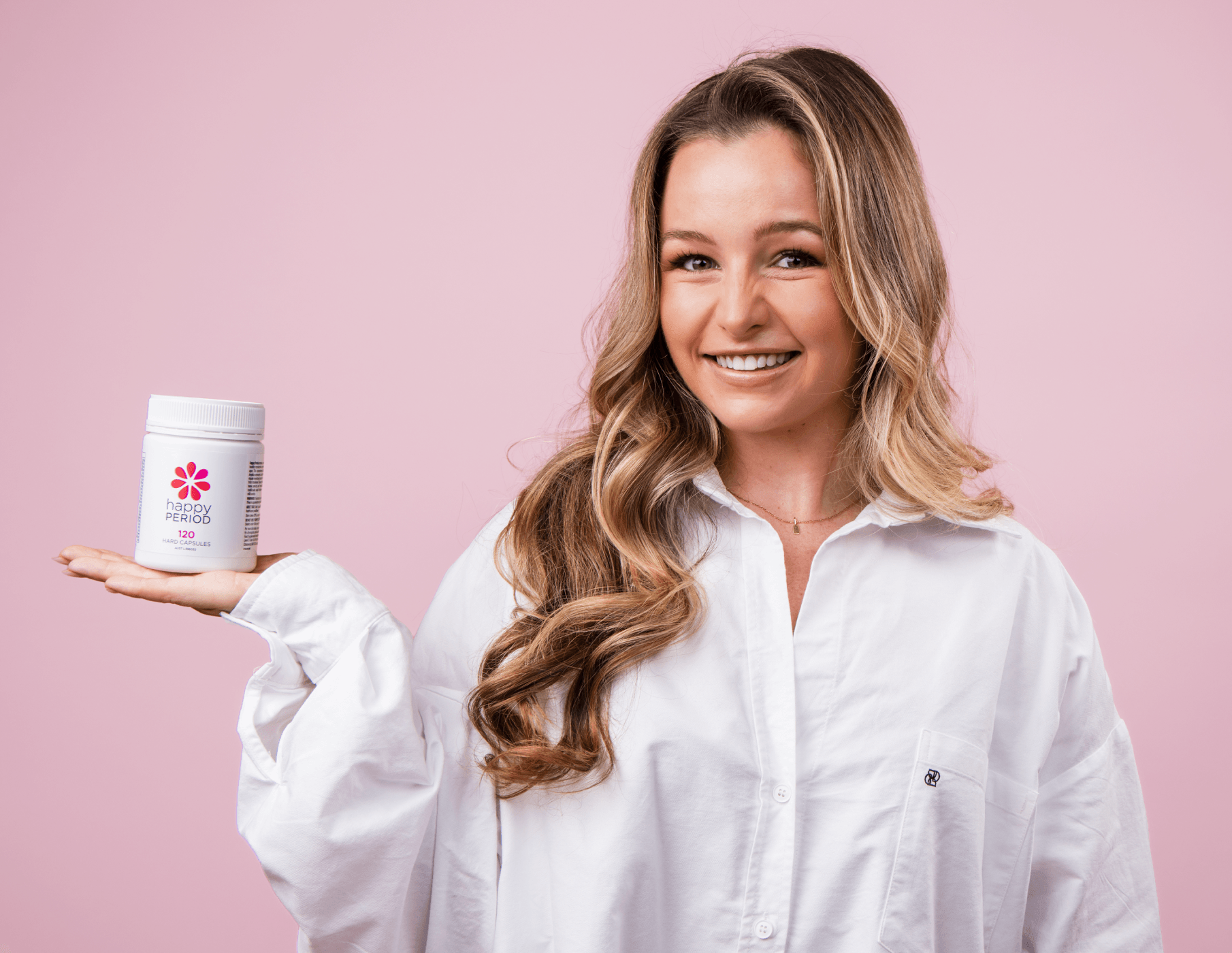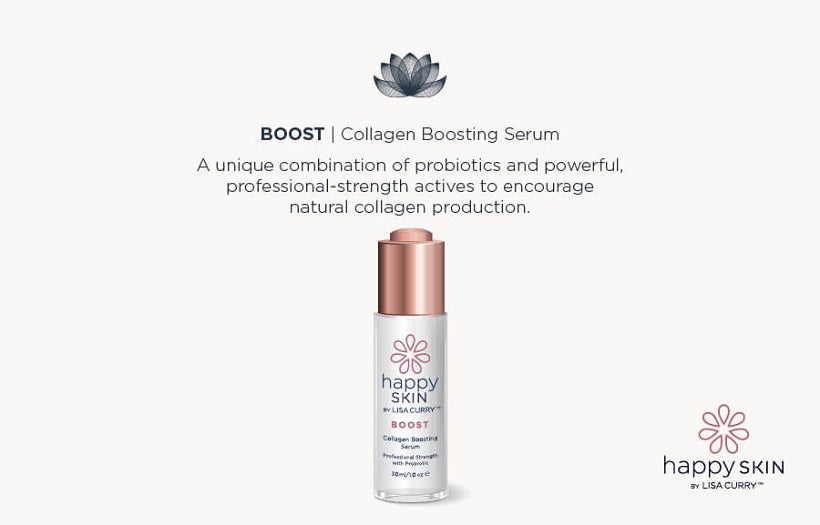Exfoliating Face Mask Benefits
By Renee Grandi

When it comes to a great exfoliating face mask, it’s all about providing the skin with nourishing, deep-penetrating nutrients to reduce oxidative stress and rejuvenate cellular membrane integrity. This article explains how the selected ingredients work based on scientific literature to support healthy skin.
We’ve constructed Happy Skin by Lisa Curry™ EXFOLIATE, the perfect, gentle exfoliating face mask to support:
- Premature ageing
- Inflamed or red skin
- Hydration and suppleness
- Dryness or flaking
- Acne or rosacea
- Sebum control (oily skin)
- Protection against external environments (UV radiation)
- Fungal or bacterial overgrowth
- Smoothness and radiance
What's in our Happy Skin by Lisa Curry™ EXFOLIATE
Jojoba (Simmondsia chinensis) Esters

Jojoba oil is a unique, high-quality skin oil sourced from one of a very few plants that have long monounsaturated esters instead of triglycerides. Due to its unconventional fat structures, jojoba oil has great stability and resistance to degradation in cosmetic products.
Jojoba’s lipids encourage skin barrier repair and protection against oxidative stress whilst deeply nourishing the cellular membrane quality and integrity. It’s proven to be highly anti-inflammatory, particularly for rashes, dermatitis, acne, dryness, skin infections and skin-aging. S. chinensis esters are a close match to natural human sebum, helping to control excessive oil production and deep layer nourishment – perfect for acne.
Microcitrus Australasica Fruit
Microcitrus Australasica fruit a.k.a. lemon caviar or finger lime fruit is an exotic Australian lime fruit found in the tropics and subtropics along the East Coast. Finger lime comprises major antioxidant nutrients and minerals such as potassium, phosphorus, magnesium, iron, zinc, manganese, selenium, copper, and cobalt.
Finger lime fruit is particularly plentiful in Vitamin E and lutein, with up to 40 fold more lutein than grapefruit. Both of these major nutrients are excellent for protecting against photo-oxidative stress (UV rays) and enhancing keratinocyte integrity. Vitamin E is ideal for preventing premature aging and is essential for healthy skin quality.
Bambusa Arundinacea Stem Extract

Also known as bamboo extract, we love this ingredient because it’s anti-bacterial, anti-inflammatory, anti-ulcerative, and helps to regulate skin glucose (sugar) metabolism. The extract is known for strengthening cartilage and tissue, particularly in the hair, skin, nails, teeth and gums.
Topically, we’re putting this lush, gentle ingredient right where we want it – on your skin. It’s ideal for inflamed skin and has proven to alleviate eczema and psoriasis. It works by modulating immunity causing pro-inflammatory cascades and is a potent free-radical scavenger. If you’re prone to skin fungal infections or fungal acne, bamboo provides therapeutic agents to inhibit the growth of nasty pathogens.
Olea Europaea Seed Powder
Olea Europaea (olive seed) powder is derived from European olive trees. The olive tree has been used for centuries to support all aspects of health, but predominantly in the skin. Olea Europaea comprises abundant antioxidants and can be used as a natural food preservative without exploiting its nutritional quality. It’s oleuropein, oleacein, oleacanthal, hydroxytyrosol or elenolic acid derivatives are also powerful anti-bacterials.
The seeds have an estimated 46% of collagen-building amino acids and essential micro/macronutrients including zinc, manganese, magnesium, calcium and potassium. They yield an estimated 11 high-quality essential fatty acids, 4 forms of vitamin E and 7 different skin boosting sterols. The seeds are another one of nature’s wonders for healing and rejuvenating skin for that dewy glow.
Asteriscus Graveolens Extract
A. graveolens (forssk) has been selected for its effective antioxidant and anti-inflammatory phytochemicals (you’re getting the picture by now that it’s all about those antioxidants!). This extract is known for its redox properties – reducing free-radicals, scavenging oxidative molecules, and damaging hydrogen donors and metal chelators.
Forssk is therapeutically a botanical anti-fungal and anti-bacterial which can significantly reduce topical infections by inhibiting pathogenic activity in its tracks! If you’re looking to reduce pore size, the extract is high in tannins and flavonoids known to shrink pores, reduce inflammation and tighten skin. Thank you mother nature!
Cichorium Intybus Root Extract

Ever heard of chicory root? It’s got some pretty unique qualities. Chicory root contains a Vitamin D ‘look-alike’ compound and increases Vitamin D receptor sites. Our skin thrives on healthy levels of Vitamin D. Within the dermal matrix vitamin D helps DNA sequencing, immune modulation and supports how cells replicate.
Chicory root shields against sun damage, skin roughness and scaling, It even enhances the way our skin’s rhomboidal pattern regenerates. Deep furrows can be improved as well as hydration. This herb is excellent for improving the skin epidermis composition and structure.
Algae Oligosaccharides
Oligosaccharides are carbohydrates, lipids, proteins, amino acids, flavonoids and nutrients derived from marine algae. Scientific literature has shown promising results for algae derivatives to support skin barrier integrity and functionality. They help increase dermal hydration, type 1 collagen and reduce premature aging. The aqueous extracts are highly anti-inflammatory and defend against internal skin DNA damage. Algae is an ideal intervention to decongest skin and its associated toxins stored within the skin matrix.
You can see how all the ingredients in our Exfoliating Face Mask work together to support healthy skin.
Want to nourish your skin from the inside out? Check our articles on Happy Liver for Skin Health and Top 6 Healing Foods for Inflamed Skin.
You may also want to check our entire range of skin care products in Happy Skin by Lisa Curry™ - The Collection.
REFERENCES
Delort E & Yuan YM. (2018). Finger lime/The Australian Caviar— Citrus australasica. Exotic Fruits, 203–210.
http://dx.doi.org/10.1016/B978-0-12-803138-4.00025-3
Denaro et al. (2020). New insights into Citrus genus: From ancient fruits to new hybrids. Food Frontiers, Vol 1:3; 305-328.
https://doi.org/10.1002/fft2.38
Habasy RR, Abdel-Naim AB, Khalifa AE, and Al-Azizi MM. (2005). Anti-inflammatory effects of jojoba liquid wax in experimental models. Pharmacological Research, Feb;51(2):95-105.
https://doi.org/10.1016/j.phrs.2004.04.011
Kim JH, Lee JE, Kim KH and Kang NJ. (2018). Beneficial Effects of Marine Algae-Derived Carbohydrates for Skin Health. Marine Drugs. Nov; 16(11): 459.
https://dx.doi.org/10.3390%2Fmd16110459
Lin T, Zhong L, and Santiago JL. (2017). Anti-Inflammatory and Skin Barrier Repair Effects of Topical Application of Some Plant Oils. International Journal of Molecular Sciences. Jan; 19(1): 70.
https://dx.doi.org/10.3390%2Fijms19010070
Maestri et al. (2019). Nutritional profile and nutraceutical components of olive (Olea europaea L.) seeds. Journal of Food Science and Technology. Sep; 56(9): 4359–4370.
https://dx.doi.org/10.1007%2Fs13197-019-03904-5
Campos M, Mercurio G, Melo O, and Closs-Gonthier B. (2016). Cichorium intybus root extract: A “vitamin D-like” active ingredient to improve skin barrier function. Journal of Dermatological Treatment, 28(1):78-81.
https://doi.org/10.1080/09546634.2016.1178695
Meier L, Stange R, Michalsen A, and Uehleke B. (2012). Clay Jojoba Oil Facial Mask for Lesioned Skin and Mild Acne Results of a Prospective, Observational Pilot Study. Research in Complementary Medicine, 19(2):75-9.
https://doi.org/10.1159/000338076
Ramdane et al. (2017). Phytochemical composition and biological activities of Asteriscus graveolens (Forssk) extracts. Process Biochemistry, 56.
http://dx.doi.org/10.1016/j.procbio.2017.03.004
Sánchez et al. (2016). Jojoba oil: A state of the art review and future prospects. Energy Conversion and Management, 129:293-304.
http://dx.doi.org/10.1016/j.enconman.2016.10.038
Sangeetha R, Diea YKT, Chaitra C, Malvi PG, and Shinomol GK. (2015). The Amazing Bamboo: A Review on its Medicinal and Pharmacological Potential. Indian Journal of Nutrition, 2(1): 106.
https://www.opensciencepublications.com/wp-content/uploads/IJN-2395-2326-2-106.pdf
Thielmann J, Kohnen S, and Hauser C. (2017). Antimicrobial activity of Olea europaea Linné extracts and their applicability as natural food preservative agents. International Journal of Food Microbiology, Jun 19;251:48-66.
https://doi.org/10.1016/j.ijfoodmicro.2017.03.019
Vaughn AR, Clark AK, Sivamani RK, and Shi VY. (2017). Natural Oils for Skin-Barrier Repair: Ancient Compounds Now Backed by Modern Science. . American Journal of Clinical Dermatology, Feb;19(1):103-117.
https://doi.org/10.1007/s40257-017-0301-1







Leave a comment
This site is protected by hCaptcha and the hCaptcha Privacy Policy and Terms of Service apply.